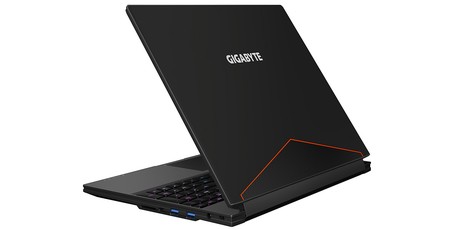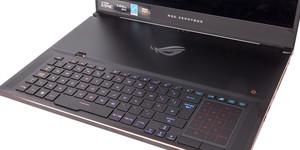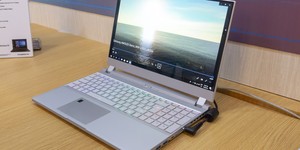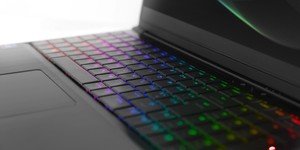Manufacturer: Gigabyte
UK price (as reviewed): £1,899.95 (inc. VAT)
US price (as reviewed): Currently unavailable
While Ultrabooks like the Dell XPS 13 are the ultimate PCs for portability, the 15.6” form factor is a popular one for gaming laptops, as it permits machines that are both powerful enough to play modern games well yet small enough so as to not be too cumbersome to carry around like full-fat 17” (or higher) desktop replacement units can be. If you can’t resist gaming when you’re on the move, or simply want one machine for everything, it’s likely a 15.6” will strike an appropriate balance between performance and portability. The question, as ever, is thus which one? Hoping to win you over today is the Gigabyte Aero 15W, sporting a six-core Intel CPU and GTX 1060 6GB.
This isn’t the first laptop we’ve seen with those core specs, so it’ll be interesting to see how the Aero 15W compares to the PC Specialist Recoil II, which can be configured to the same spec as that which we reviewed currently for £1,333. That’s exceptional value for this hardware; the £1,900 Gigabyte Aero 15W is clearly chasing a more premium market much like the Razer Blade 15 or Dell XPS 15.

Thankfully, Gigabyte has done a good job with the CNC-milled aluminium chassis. It has a premium look and feel all round, and doesn’t compress too easily anywhere. Our unit tipped the scales at 2.07kg, which is suitable for carrying around. Its 18.9mm depth is about 3mm below the PC Specialist unit, but the Dell and Razer competitors are thinner still.
The six-core, 12-thread Core i7-8750H is a potent 45W CPU for gaming, balancing efficiency, multi-threading, and speed very nicely. Its Coffee Lake cores can peak at 4.1GHz, but under full load the cores balance out to 2.8GHz or 2.9GHz. It comes here paired with a single 16GB stick of G.Skill Ripjaws 2,666MHz DDR4, leaving one RAM slot free. The GTX 1060 6GB is also a great weapon in the fight for frame rates, especially at the native resolution of 1080p.

A downside to the thin bezels is that the webcam is positioned under the screen, which will lead to an unflattering angle. This may or may not be a bugbear depending on how often you actually need to use your webcam – anyone interested in streaming, though, will likely want to invest in an external one.

All ports are located along the sides and thus easily accessed. On the right you have dual USB 3.0 ports, the charging input, a single USB 3.1 Type-C header with Thunderbolt 3 40Gbps support, and a UHS-II-compatible SD card reader. The left hosts a LAN port, a USB 3.1 Type-A connector, HDMI 2.0 and mini-DisplayPort 1.4 video outputs, and a single audio jack with combined headphone and microphone functionality. Triple 60Hz 4K panels can be run via a combination of these ports for anyone looking to dock the unit.
Internally, storage is a little basic since you only have a single 525GB Crucial MX300 SSD, which is SATA-based and thus capped in access speeds and peak performance compared to NVMe-based SSDs, which is what we expect at this price. Users can upgrade the machine with their own NVMe SSD, as there is a slot on the motherboard to do so, but still this is a real downside.

The keyboard spans the full width of the unit and grants you properly sized arrow keys and a numpad. It offers 80-key rollover, and the key response is pleasant enough; resistance feels a bit high at first but you do get used to it. We tend to prefer trackpads with separate buttons, but we understand the appeal of a sleek unibody like this one. While most gamers will be using a mouse, be aware that using the trackpad involves resting your palm against the uncomfortable lower edge – it was noticeable and distracting.
Gigabyte Fusion support means RGB backlighting for the full keyboard, and users may also note that the Gigabyte logo on the lid illuminates white. The quality of the lighting is decent, with whites not looking too skewed in any one direction. You can set per-key RGB patterns in static mode or a handful of other effects using the software. Multiple profiles, organised in handy tabs, are available, and they can be assigned to specific apps and games too. Keys can also be reprogrammed to shortcuts, media or fan control, or custom macros, though we noticed a delay when executing custom commands, which makes it pointless for gamers, at least until an update addresses it. Overall, it’s not a bad effort, but Razer’s Synapse solution is inarguably better and slicker on every front, so in truth Gigabyte still has a ways to go here.

Removing the bottom panel reveals a massive battery with a huge 94Wh capacity. The DC charger itself is pretty slimline also and has its own powered USB port for device charging. The layout makes it dead simple to add or change the memory or storage configuration too. For cooling, there are large vents cut into the bottom serving the dual-fan cooler with double heat pipes. Hot air is exhausted out of the back, but the screen mechanism will block airflow – it’s not a clear path out, unfortunately.

The Windows 10 Pro installation includes Gigabyte’s Smart Manager software that has some useful settings like fan control with presets as well as custom modes that actually go pretty deep i.e. it can be used to set completely custom curves. There’s a bunch of other apps too, and honestly it does feel rather bloated, as not all of these feel necessary, although having some control over the screen colour options is nice.
The BIOS is a basic blue and white affair with no surprising options and no interesting controls.
The Aero 15W comes with a full two-year warranty, and it’s also part of a ‘Make Earth Green Again’ program that will see a tree planted if it’s registered with Gigabyte.
Specifications (as reviewed)
- CPU Intel Core i7-8750H (2.2GHz base, 4.1GHz Turbo)
- CPU threads 12 (six-core with Hyper-Threading)
- Memory 16GB (1 x 16GB) G.Skill Ripjaws 2,666MHz DDR4
- Graphics Nvidia GeForce GTX 1060 6GB
- Storage 1 x Crucial MX300 525GB M.2 SATA SSD
- Screen 15.6" IPS, 1,920 x 1,080, 144Hz, X-Rite Pantone certified
- Dimensions (mm) 356.4 x 250 x 18.9 (W x D x H)
- Networking Intel 802.11ac Wi-Fi, Bluetooth 4.2 + LE
- Audio Dolby Atmos, 2 x 2W speakers
- Keyboard backlighting Yes (Gigabyte RGB Fusion)
- Battery Li-Ion, 94.24Wh
- Webcam HD
- Weight 2.07kg
- Operating system Windows 10 Pro 64-bit
- Ports 1 x Thunderbolt 3 USB Type-C, 1 x USB 3.1 Type-A, 2 x USB 3.0, HDMI
2.0, 1 x mini-DisplayPort 1.4, 1 x Gigabit LAN, 1 x 3.5mm
headphone/microphone combined jack, 1 x SD card reader
- Warranty Two years

MSI MPG Velox 100R Chassis Review
October 14 2021 | 15:04









Want to comment? Please log in.